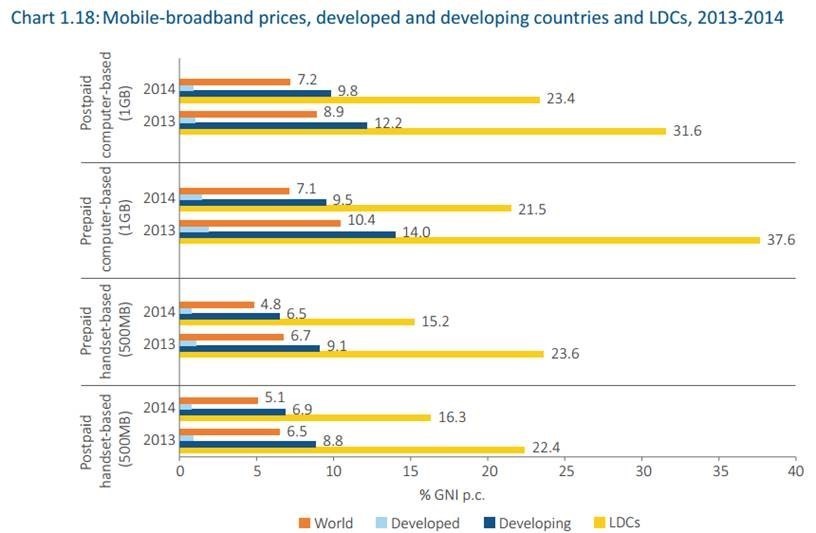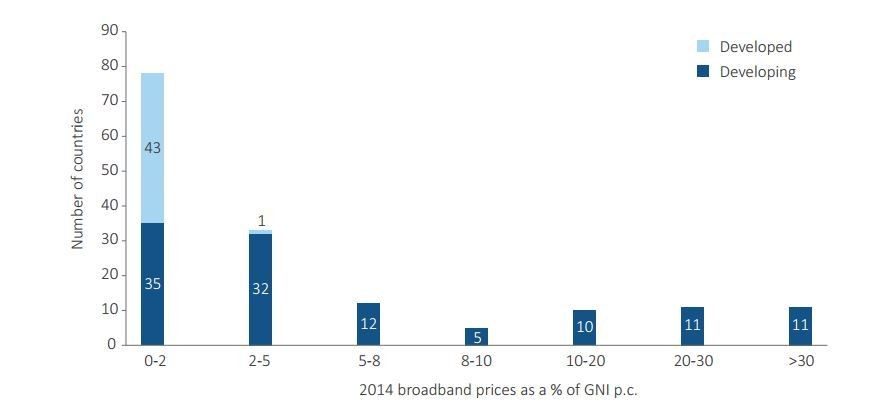How far are we from internet access for all?

Image: People use computers at an internet cafe in the Hodan area of Mogadishu. Reuters/Feisal Omar

Get involved with our crowdsourced digital platform to deliver impact at scale
Stay up to date:
The Digital Economy
New developments and curiosities from a changing global media landscape: People, Spaces, Deliberation brings trends and events to your attention that illustrate that tomorrow's media environment will look very different from today's, and will have little resemblance to yesterday's.
In recent years, as the number of mobile-cellular subscriptions surpassed 7.1 billion and mobile network population coverage approached close to 95%, growth in mobile subscriptions has greatly exceeded the growth in fixed connections, especially in developing countries. For many low-income groups, mobile devices are their only window to internet access.
The tremendous growth has not only contributed to greater access rates, but also to a fall in prices of mobile-cellular services around the world as providers seek to be competitive. Over the past year, the decrease in mobile-broadband prices worldwide made it, on average, 20 – 30% more affordable. In least developed countries (LDCs), the mobile-cellular price basket continued to fall to 14% of GNI per capita by the end of 2014, compared with 29% in 2010.
Nevertheless, as the following graph from Measuring the Information Society Report 2015 by the International Telecommunication Union (ITU) illustrates, LDCs have a long way to go in order to achieve affordable mobile-broadband packages. The graph shows, the average prices for pre- and post-paid broadband connections on computers and mobile devices, as measured against monthly GNI per capita, in 2013 and 2014.
Among the options, prepaid mobile-broadband is the most affordable. In this context, it will be important for broadband providers to offer more new services and packages for low-income groups, such as allowing users to buy data in small volumes.

In 2014, the ITU adopted the Connect 2020 Agenda, which includes four goals (comprising of 17 targets) that focus on monitoring and stimulating the development of the ICT sector between 2015 and 2020. Among the goals were reducing the affordability gap between developed and developing countries by 40% and ensuring that broadband services should cost no more than 5% of average monthly income in developing countries by 2020.
According to the ITU, by early 2015, a total of 111 economies out of 160 for which data were available had achieved that target, including all of the developed countries and 67 developing countries in the data set. Of the 11 that had reached the target, 102 had achieved it for fixed-broadband prices and 105 for mobile-broadband prices. However, a small number of countries had very much higher broadband prices, including 22 countries with broadband prices that are more than 20% of monthly GNI per capita.

Don't miss any update on this topic
Create a free account and access your personalized content collection with our latest publications and analyses.
License and Republishing
World Economic Forum articles may be republished in accordance with the Creative Commons Attribution-NonCommercial-NoDerivatives 4.0 International Public License, and in accordance with our Terms of Use.
The views expressed in this article are those of the author alone and not the World Economic Forum.
The Agenda Weekly
A weekly update of the most important issues driving the global agenda
You can unsubscribe at any time using the link in our emails. For more details, review our privacy policy.
More on Industries in DepthSee all
Robin Pomeroy
April 25, 2024
Abhay Pareek and Drishti Kumar
April 23, 2024
Charlotte Edmond
April 11, 2024
Victoria Masterson
April 5, 2024
Douglas Broom
April 3, 2024
Naoko Tochibayashi and Naoko Kutty
March 28, 2024






